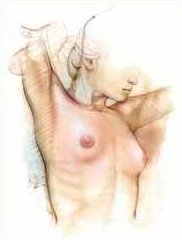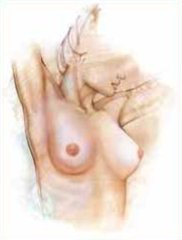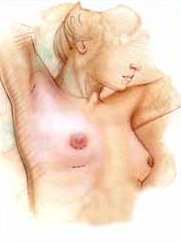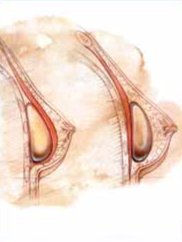Breast Augmentation (Enlargement)
Many women choose to have their breasts enlarged in order to satisfy their own desire for a fuller bustline. Your breasts may not have developed to a size that meets your expectations, or one breast may be significantly smaller than the other. You may have been happy with your breasts in the past but feel that they look different now. Often, after weight loss, childbirth or as a result of aging, the breasts lose volume and their shape changes. Breast augmentation can enhance your breast size and shape, and give you the more proportional figure that you always wanted.


Am I a good candidate for breast augmentation?
One or more of the following feelings or conditions may indicate that you are a good candidate for breast augmentation:
- You are bothered by the feeling that your breasts are too small
- Clothes that fit well around your hips are often too large at the bustline
- You feel self-conscious wearing a swimsuit or form-fitting top
- Your breasts have become smaller and lost their firmness after having children
- Weight loss has changed the size and shape of your breasts
- One of your breasts is noticeably smaller than the other
Your Personal Consultation
During the consultation, you will be asked about your desired breast size and anything else related to the appearance of your breasts that you feel is important.
This will help your surgeon to understand your expectations and determine whether they realistically can be achieved.
How will I be evaluated for breast augmentation surgery?
Your plastic surgeon will examine your breasts and perhaps take photographs for your medical record. He or she will consider such factors as the size and shape of your breasts, the quality of your skin and the placement of your nipples and areolas (the pigmented skin surrounding the nipples). If your breasts are sagging, a breast lift may be recommended in conjunction with augmentation.
You should come to the consultation prepared to discuss your medical history. This will include information about any medical conditions, drug allergies, medical treatments you have received, previous surgeries including breast biopsies, and medications that you currently take. You will be asked whether you have a family history of breast cancer and about results of any mammograms. It is important for you to provide complete information.
If you are planning to lose a significant amount of weight, be sure to tell your plastic surgeon. He or she may recommend that you stabilize your weight prior to undergoing surgery.
If you think that you may want to become pregnant in the future, you should mention this to your surgeon. Pregnancy can alter breast size in an unpredictable way and could affect the long-term results of your breast augmentation. There is no evidence that breast implants will affect pregnancy or your ability to breast-feed, but if you have questions about these matters, you should ask your plastic surgeon.
How should I prepare for surgery?
In some instances, your plastic surgeon may recommend a baseline mammogram before surgery and another mammographic examination some months after surgery. This will help to detect any future changes in your breast tissue. Following breast augmentation, you will still be able to perform breast self-examination.
If you are a smoker, you will be asked to stop smoking well in advance of surgery. Aspirin and certain anti-inflammatory drugs can cause increased bleeding, so you should avoid taking these medications for a period of time before surgery. Your surgeon will provide you with additional preoperative instructions.
Breast augmentation is usually performed on the basis of a one/two night stay in the hospital.
What will the day of surgery be like?
Your breast augmentation surgery will be performed in a hospital.
Medications are administered for your comfort during the surgical procedure. The procedure will be performed under general anaesthesia.
When surgery is completed, you will be taken into a recovery area where you will continue to be closely monitored. Your breasts will be wrapped in gauze dressings or a surgical bra.
You may be permitted to go home after your drains have been removed and all is well.
How will I look and feel initially?
A day or two after surgery, you should be up and about. Any dressings will be removed within several days, and you may be instructed to wear a support bra. Your plastic surgeon will probably permit you to shower between three and seven days following surgery. Stitches will be removed in about a week.
Some discoloration and swelling will occur initially, but this will disappear quickly. Most residual swelling will resolve within a month.
When can I resume my normal activities?
After breast augmentation surgery, it is often possible to return to work within just a few days or a week, depending on your job. Vigorous activities, especially arm movement, may be restricted for two to three weeks.
Sexual activity should be avoided for at least the first four weeks following surgery. After that, care must be taken to be extremely gentle with your breasts for at least the next month.
How Breast Augmentation is Performed
Individual factors and personal preferences will help you and your plastic surgeon to determine your appropriate breast size, the location of incisions, and whether the implants will be placed on top of or underneath the chest muscle.

An incision can be made either underneath the breast, just above the crease, around the lower edge of the areola or within the armpit.

The implant is placed in a pocket either directly behind the breast tissue (right) or underneath the pectoral muscle, which is located between the breast tissue and chest wall.
What type of implants will be used?
All implants regardless of whether they are saline or silicone filled, still have their external shell made of silicone.
The preferred implants especially in the light of the report confirming the safety of silicone implants, are those containing silicone.
Silicone implants are of two types:
- Where the silicone exists in the form of a gel that oozes when the implants ruptures or is cut.
- Cohesive implants- where the gel is jelly like at body temperature but does not flow when the implant ruptures or is cut
Where are the incisions placed?
An incision of approximately 5 cms is made underneath the breast, just above the crease, where it is usually quite inconspicuous.
Once the incision is made, the surgeon creates a pocket into which the implant will be inserted. This pocket is made either directly behind the breast tissue or underneath the pectoral muscle, which is located between the breast tissue and chest wall.
Understanding Risks
Every year, many thousands of women undergo successful breast augmentation surgery; however, anyone considering surgery should be aware of both the benefits and risks.
The subject of risks and potential complications of surgery is best discussed on a personal basis between you and your plastic surgeon, or with a staff member in your surgeon's office.
Some of the potential complications that may be discussed with you include:
Those associated with the operative procedure:
- Scarring; permanent, visible, lumpy scars
- Bleeding, use of drains, haematoma (blood accumulation that may need to be drained surgically)
- Infection. Although rare, an infection that does not subside with appropriate treatment may require temporary removal of the implant.
- Changes in nipple or breast sensation may result from breast augmentation surgery, although they usually are temporary.
- Mild asymmetry especially when the breasts are uneven to begin with.
Those associated with the implant:
- Capsule formation. When a breast implant is inserted, a scar capsule forms around it as part of the natural healing process. The capsule may sometimes tighten and compress the implant, causing the breast to feel firmer than normal. Capsular contracture can occur to varying degrees. If it is severe, it can cause discomfort or changes in the breast's appearance. In such cases, more surgery may be needed to modify or remove the scar tissue, or perhaps remove or replace the implant.
- Life of the implant. Breast implants are not lifetime devices and cannot be expected to last forever. If an implant ruptures it is usually noticed in the form of inequality of the breasts and the breast becoming smaller.
- Infection of the implant as discussed earlier.
- Need for MRI imaging to define any rupture of the implant within its capsule. In such cases the breast may not become smaller as the contents of the implant are still retained within the breast.
Screening Mammography post augmentation
It is possible to have mammographic evaluation of breasts following implant insertion. You will need to notify the radiographer/radiologist who will take special views to delineate breast tissue.
The Silicone Controversy
The Independent Review Group (IRG) set up by the Department of Health to review the safety of silicone implants published its report in 1998. The salient findings were
- No scientific relationship between silicone implants and immune reaction.
- No relationship between silicone implants and connective tissue disorders.
- Silicone is not secreted in breast milk.
- No scientific relationship between silicone implants and breast cancers in females.
Results of Breast Augmentation
Breast augmentation will make your breasts fuller and enhance their shape. You will find it easier to wear certain styles of clothing. Like many women who have had breast augmentation, you may have a boost in self-confidence.
How long will the results last?
Except in the event of implant deflation requiring surgical replacement with a new implant, the results of your breast augmentation surgery will be long-lasting. However, gravity and the effects of aging could eventually alter the size and shape of virtually every woman's breasts. If, after a period of years, you become dissatisfied with the appearance of your breasts, you may choose to undergo a breast "lifting" to restore their more youthful contour.